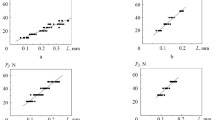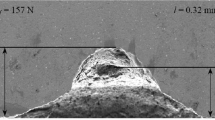Abstract
Chipping in glass plates from line-wedge contact loading is studied as function of the wedge’s subtended angle 2β, its inclination angle ϕ, and the distance h from a corner having a subtended angle 90° − θ A brittle-fracture analysis in conjunction with the FEM technique is used to elucidate the role of geometric variables on chip morphology and chipping load. Closed-form relations are developed for the latter by invoking the principle of geometric similarity and taking into consideration the details of contact forces transmitted to the crack mouth. The fracture progresses stably until surface effects alter the crack trajectory to form a chip. The latter conclusively occurs from the top surface if ϕ > β while from the side wall if ϕ < β. The fracture load for top-surface spalling scales with w 1/2, where w is the indentation depth, and it monotonically declines with the offset angle ψ ≡ - ϕ β, that for side-wall chipping scales with h 1/2 and it is little sensitive to ϕ for moderate values of θ In both the cases, the chipping load increases with β. The results may provide insight into the mechanics of chipping in more complex anthropological, tribological, geological and biomedical applications, including flint-knapping, dental fracture, grinding and polishing and common cutting and machining operations.
Similar content being viewed by others
References
Chai H (2003). Fracture analysis of thin coatings under plane-strain indentation. Int J Solids Struct 40: 591–610
Chai H and Lawn BR (2006). Failure of brittle layers on polymeric substrates from Vickers indentation. Scrip Mater 55: 335–338
Chai H and Lawn BR (2007a). A universal relation for edge chipping from sharp contacts in brittle materials and its use as a simple means of toughness evaluation. Acta Mater 55: 2555–2561
Chai H and Lawn BR (2007b). Edge chipping of brittle materials: effect of side-wall inclination and loading angle. Int J Frac 145: 159–165
Chai H and Ravichandran G (2007). Transverse fracture in multilayers from uniform tension or line-wedge. Int J Frac 145: 299–312
Chiu WC, Thouless MD and Endres WJ (1998). An analysis of chipping in brittle materials. Int J Frac 90: 287–298
Cotterell B and Kamminga J (1986). Finials on stone flakes. J Archaeol Sci 13: 451–461
Cotterell B and Kamminga J (1987). The formation of flakes. Am Antiq 52: 675–708
Cotterell B, Kamminga J and Dickson FP (1985). The essential mechanics of conchoidal flaking. Int J Frac 29: 205–221
Danzer R, Hangl M, Paar R (1997) How to design with brittle materials against edge flaking. In: 6th International Symposium on Ceramic Materials and Components for Engines 1997, pp 658–662
Datsyshyn OP, Panasyuk VV, Pryshlyak E and Terlets’kyi AB (2001). Paths of edge cracks in rolling bodies under the conditions of boundary lubrication. Mater Sci 37: 363–373
Gogotsi GA (2006). Fracture resistance of ceramics: base diagram and R-line. Strength Mater 38: 261–270
McCormick NJ (1982). Edge flaking as a measure of material performance. Met Mater 8: 154–156
Pelcin AW (1997). The formation of flakes: the role of platform thickness and exterior platform angle in the production of flake initiations and terminations. J Archaeol Sci 24: 1107–1113
Quinn JB, Su L, Flanders L and Lloyd IK (2000). “Edge toughness” and material properties related to the machining of dental ceramics. Mach Sci Technol 4: 291–304
Scieszka SC (2001). Wear transition as a means of fracture toughness evaluation of hardmetals. Tribol Let 11: 185–194
Swenson DV (1990). Finite element analysis of edge cracking in plates. Eng Frac Mech 37: 641–652
Thouless MD, Evans AG, Ashby MF and Hutchinson JW (1987). The edge cracking and spalling of brittle plates. Acta Met 35: 1333–1341
Author information
Authors and Affiliations
Corresponding author
Additional information
Herzl Chai—On leave, School of Mechanical Engineering, Tel Aviv University, Israel.
Rights and permissions
About this article
Cite this article
Chai, H., Ravichandran, G. On the mechanics of surface and side-wall chipping from line-wedge indentation. Int J Fract 148, 221–231 (2007). https://doi.org/10.1007/s10704-008-9196-4
Received:
Accepted:
Published:
Issue Date:
DOI: https://doi.org/10.1007/s10704-008-9196-4




